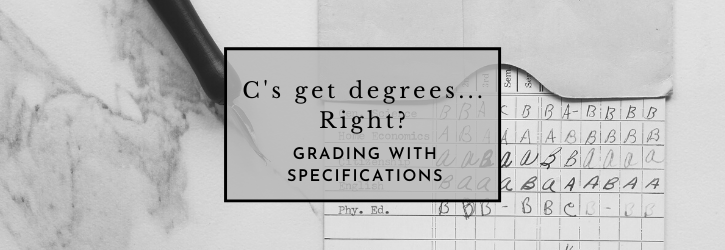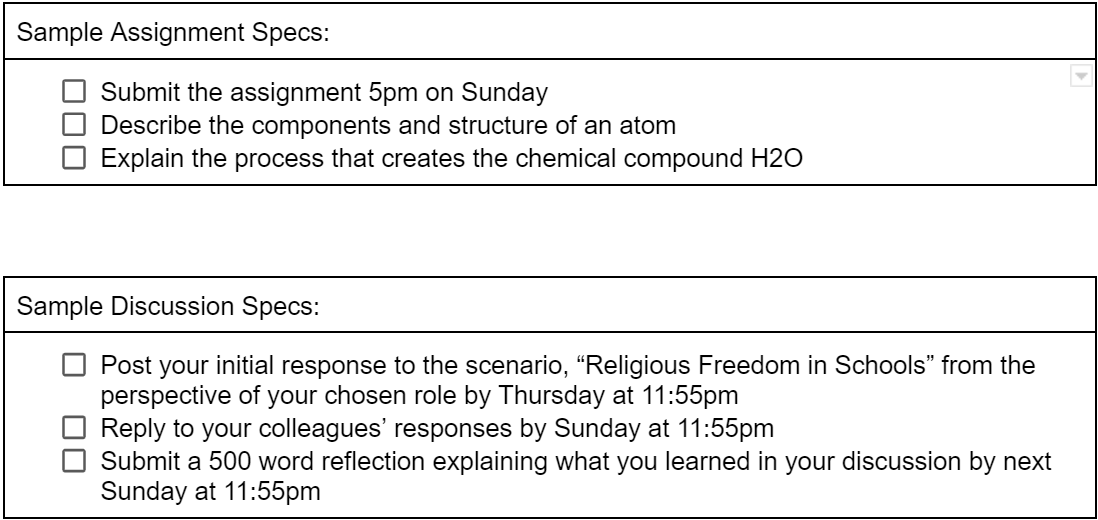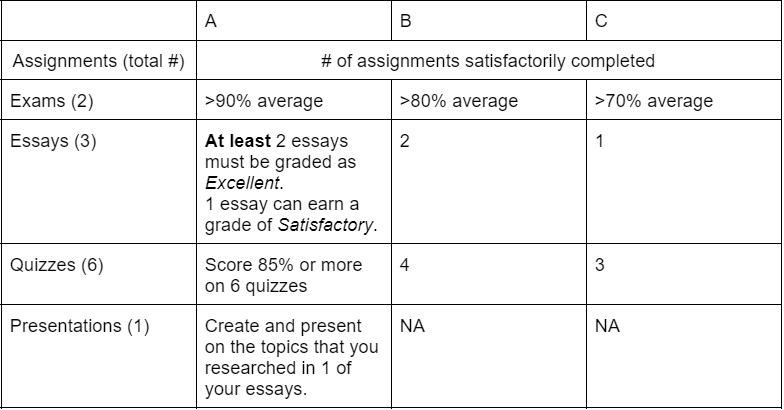Blogs

C's Get Degrees . . . Right? Grading With Specifications
By Kent Darr
Everyone’s heard the phrase, “C’s get degrees,” in their careers, and - let’s be honest - have maybe even thought it to themselves during a particularly difficult stretch in their time as students. Given this uncomfortable truth, it’s worth asking ourselves the question, “do traditional points-based grading system is actually working to develop skilled professionals, life-long learners and well-rounded citizens?” According to Linda Nilson, author of Specifications Grading, that answer is a resounding "no":
The partial-credit point system turns grades—and really all college course work—into a game, the object of which is to maximize the number of points toward one’s grade with the lowest possible investment of time and effort.
But what - if any - alternative grading methods exist that could motivate students to higher levels of achievement in a scalable form? Nilson argues that Specifications (or Spec.) Grading can leverage the structures of the traditional grading system while imbuing students with a sense of motivation to learn and master topics deeply.
So What Do I Need to Do?
As a form of pass/fail grading, Spec. Grading is the ultimate answer to, “I didn’t understand what to do on the assignment.” In its most basic form, Spec. Grading requires the instructor to analyze their assignments for a core set of specs (criteria) that are essential to mastering the competencies embedded within the exercise. Once a list of specs has been finalized, the instructor creates documentation such as a set of instructions or guidelines that clearly explains each of the specs, and describes the evaluation process - most importantly that students will earn either a 100% on the activity, or 0% depending on their adherence to the list of specs that were previously laid out.
As you can imagine, Spec. Grading is going to work really well for assessments like papers, projects, or presentations that measure higher levels of mastery along Bloom’s Taxonomy. But because specs themselves are instructor-defined, they are dynamic enough to be adapted to all types of activities that can make up the final grade including quizzes, tests, discussions, and even attendance. For example, a quiz spec could be as simple as taking the quiz, or as rigorous as answering every question correctly. Similarly, a discussion spec may require only that the student post twice within a week, or it may go so far as to assign students specific roles which they must use to analyze a scenario by posting 5 times within a two day period. This flexibility can provide the instructor with a unified pass/fail system of grading that can adjust to the level of rigor that is appropriate to the assignment or subject matter.

If you’re a really big fan of performance-based rubrics or would like to get more comfortable with this new philosophy first, you might try specing your final grading system instead. Start by identifying each of the normal subcategories of assessments – Tests, Quizzes, Assignments, Essays, Participation, Etc. - then create performance criteria that increase in rigor the higher that they appear along the grading scale. For example, reaching the spec for the Quizzes in the B gradeband may require a student to complete 10 quizzes while scoring above 80%, but to achieve an A, the student will need to score at least 90% on 12 quizzes. This similar dynamic should play out with each subcategory, so that A or B level work will always require that the student demonstrates a more rigorous level of mastery, and you may even place additional assignments in the A gradeband to clearly demonstrate the difference in rigor for the top-performing students.
As you might already be thinking, establishing specs at final grade bands can have both positive and negative consequences. On a positive note, spec’d grades will lay a foundation of high expectations for your class, while also removing the anxieties that points-based grading has baked into the system (Nilson, 2015). However, this transparency can also allow your students to cynically “pick” their grades by completing only the work required at the B or C gradebands. While that is undeniably true, it also releases both the student and yourself from the illusion that they are attempting to excel in your class, and can help to reduce any fighting for grades that might have occurred under the points-based system.
Can I Get some Extra Credit?!
Whether you adopt Spec. Grading at the assignment or course level, students will inevitably ask for extra credit opportunities. To nip this in the bud, Spec. Grading encourages the use of a token economy that entrusts your students to direct their own learning practices because they must proactively track if and when they should use second chances. Further, tokens can help to create a far more equitable system than extra credit ever could because they are not arbitrary or circumstantial like extra credit opportunities can be (Bayrakter, 2020). Rather, tokens clearly grant all students the right to second chances and open up yet another pathway for students to strengthen their self-directed learning skills.

Spec. Grading: A “C” Change
The methods of Spec. Grading that I have described here have been relatively basic, and require a minimal amount of investment to add into your course, which makes it both versatile and scalable. And that’s the beauty of the method. Because Spec. Grading can be so easily adopted en masse, it has the potential to transform both the classroom experience and the utility of the transcript outside of the institution. In other words, C’s may continue to get degrees, but A’s and B’s will send a clearer, more meaningful message about student credentials than they ever have.
